CAA News Today
International News: The Treasures of the Punjab Archives, Lahore, Pakistan
posted Sep 28, 2020
The following article was written in response to a call for submissions by CAA’s International Committee. It is by Kanwal Khalid, Director of the Punjab Archives, Lahore, Pakistan, and an alumna of the CAA-Getty International Program.
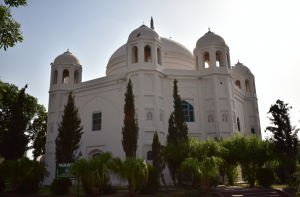
Figure 1. The Punjab Archives, housed in the Tomb of Anarkali, a building from the reign of Mughal Emperor Jahangir (1605-1627). (All photographs in this article provided by the author)
Having spent my career as a university professor, I recently was appointed the director of the Punjab Archives in Lahore. This rich collection is one of the best in South Asia and I am pleased to share a description of the institution, which also includes a library and museum, with readers of CAA News, who will soon be able to access many of the collection’s materials online.
The history of every nation is important and documents that reveal a nation’s history become increasingly precious over time. The majority of these documents are held in archives—collections that are both accumulations of historical data and repositories of record. Pakistan contains many rich archival collections: The National Archives of Pakistan and the National Documentation Centre, both located in Islamabad; the Sindh Archives in Karachi; and the Baluchistan Archives in Quetta. But the oldest of them all is the Punjab Archives in Lahore, located inside the Tomb of Anarkali.
The Punjab Archives is significant both for the immense value of its holdings and for the historical importance of its building (Fig.1), which was built during the reign of Mughal Emperor Jahangir (1605-1627). It was originally a tomb attributed to a woman named Anarkali, traditionally thought to be a concubine of Jahangir’s. According to the date written on the cenotaph, the monument was completed in 1615. The building has witnessed many ups and downs in its four-hundred-year history. After the annexation of Punjab by the British in 1849, the building was used as storage for documents pouring in from all parts of South Asia that were under the control of the British Raj. Two years later it became a church used for Sunday services, but in 1891 it was declared a record office.
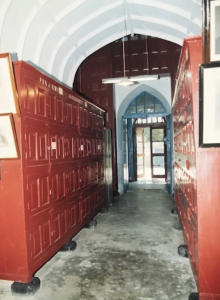
Figure 2. Inside view of the Archives.
Punjab Archives Collection
The Punjab Archives (Figs. 2, 3a-b) holds one of the largest repositories of documents in South Asia and it is responsible for the safekeeping of official documents and records of the Pakistan government. It houses census reports, civil and military gazettes, official files, historical documents, manuscripts, handouts, brochures, pamphlets, maps, notifications, memoranda, lithographs, research papers, journals, magazines, newspapers and periodicals. Many of these cannot be found anywhere else in the world. The archive also includes a fine collection of miniature paintings and seals.
The records in the Punjab Archives date back to the seventeenth century and cover the Mughal, precolonial, colonial and postcolonial eras in South Asia. Primarily the collection consists of:
- Persian Record of Mughal Period, 1629-1858
- Persian Record of Sikh Period, 1799-1849
- Akhbar Darbar-e-Lahore (Daily Court Proceedings of Sikh Rulers), 1835-1849
- Persian Record of British Period, 1809-1890
- Old Persian Newspapers, 1840-1845
- Colonial Agencies Record, 1804-1849
- Record of Princely States in Punjab, 1849-1947
- Record After the Annexation, 1849 to 1947
- Record After Independence, 1947
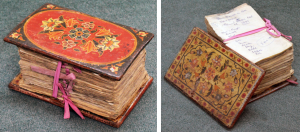
Figure 3a, b. Beautifully illuminated wooden boards used as file holders, first half of 19th century.
The Archival Library
Sir Edward Meclagan served as chancellor of University of the Punjab (1919-1924) and Governor of Punjab (1923). He was a historian whose passion for knowledge is evidenced by his donation of rare and out of print books to the Archives. This initiative led to the establishment of a small but important library that still exists today.
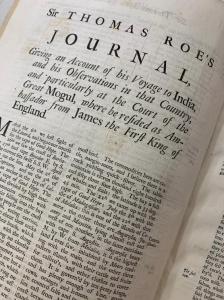
Figure 4. The oldest book in the Archives Library, Sir Thomas Roe’s Journal, 1616.
The collection consists of biographies, reports and travelogues. Currently the library holds more than 70,000 highly valuable reference books. The oldest book is a memoir, Journal of Sir Thomas Roe, which dates to 1616 and recounts the author’s journey to different parts of India (Fig. 4).
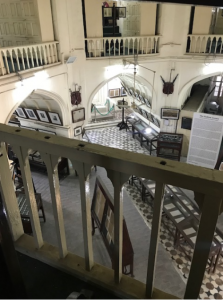
Figure 5. The central hall of the tomb, housing the Archives Museum.
Archives Museum
Another person who played an important role for the Archives was Lord Malcolm Hailey. He went one step beyond his predecessor and established a small museum in 1924 in the central hall of the tomb (Fig. 5). This collection, still maintained today, contains portraits of important Lahore personalities (Fig. 6), along with paintings, prints, maps and lithographs. Mughal Farmans (proclamations), important official letters, old stamps, medals, weapons, and miniatures are also on display (Fig. 7).
Digitization
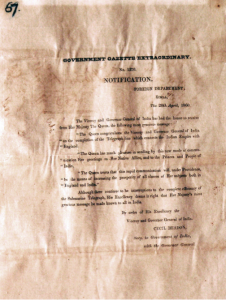
Figure 7. A message from the Queen of England to the viceroy on the completion of the telegraph line to India, 1860.
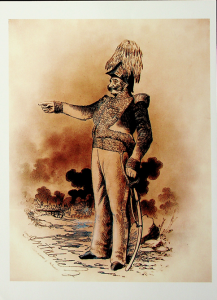
Figure 6. A general of Ranjit Singh’s army, General Avitabile, early 19th century.
For the past several years, the Punjab Archives has been in the process of digitizing its collection to improve accessibility to scholars. Approximately 500,000 pages of historic documents are currently being scanned and catalogued, precluding the need to move the fragile original documents, thus minimizing their wear and tear. A web portal will make these digitized documents accessible under the authorization of the Punjab Archives. This project is a first step towards a long-term strategy of modernizing the Punjab Archives and Libraries. To date, more then 120,000 pages have been digitized. Although the project was scheduled to be completed by June 2021, the Covid-19 pandemic has brought all activities to a standstill. Once completed, the archives online services will be a primary resource for scholars throughout the world. In the meantime we are providing information to any researcher who contacts the Archives Department by email at archivesdirectorate@gmail.com.


